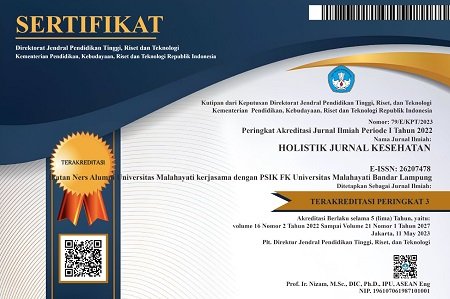Aktivitas fisik dan excessive daytime sleepiness dengan frekuensi makan selama pandemi Covid-19
Abstract
Background: The Study from Home implementation due to the Covid-19 pandemic has triggered lifestyle changes, especially in physical activities and consumption frequency. The increased use of gadgets triggers changes in sleep quality, resulting in excessive daytime sleepiness. Changes in unhealthy and inadequate food consumption can impact insufficient nutritional needs.
Purpose: Knowing the relationship between physical activity and Excessive Daytime Sleepiness (EDS) with consumption frequency in nutrition students of Universitas Airlangga during the Covid-19 pandemic.
Method: The research was an analytical observational study with cross-sectional design. The research sample was 145 nutrition students who met the inclusion criteria and were obtained through simple random sampling. Data collection instruments used the International Physical Activity Questionnaire, Epworth Sleepiness Scale, and Food Frequency Questionnaire. Data analysis used the Spearman correlation test.
Results: The majority of respondents are 20 years old (46.9%), female (93.1%), light physical activity (57.9%), normal sleepiness level (60.0%), often consume staple-foods (73.8%), side-dishes (83.4%), vegetables (64.1%), and rarely consume fruit (57.9%), energy-dense foods (67.6%). There is no relationship between physical activity (p>0.05) and EDS (p>0.05) with consumption frequency.
Conclusion: There is no relationship between physical activity and EDS with consumption frequency in nutrition students during the Covid-19 pandemic.
Suggestion: It is necessary to increase physical activity, improve sleep quality, and consumption frequency according to balanced nutrition guidelines during the Covid-19 pandemic.
Keywords: College Student; Covid-19 Pandemic; Excessive Daytime Sleepiness; Meal Frequency; Physical Activity
Pendahuluan: Penerapan Study from Home akibat pandemi Covid-19 memicu perubahan gaya hidup, terutama aktivitas fisik dan frekuensi konsumsi. Peningkatan penggunaan gadget memicu perubahan kualitas tidur yang mengarahkan pada kantuk berlebihan di siang hari. Perubahan konsumsi makan tidak sehat dan tidak adekuat akan berdampak pada ketidakcukupan kebutuhan gizi.
Tujuan: Mengetahui hubungan antara aktivitas fisik dan Excessive Daytime Sleepiness (EDS) dengan frekuensi makan mahasiswa gizi Universitas Airlangga selama pandemi Covid-19.
Metode: Jenis penelitian observasional analitik dengan desain cross sectional. Sampel penelitian sebesar 145 mahasiswa yang memenuhi kriteria inklusi dan diperoleh secara simple random sampling. Instrumen pengumpulan data menggunakan International Physical Activity Questionnaire, Epworth Sleepiness Scale, dan Food Frequency Questionnaire. Analisis data menggunakan uji korelasi Spearman.
Hasil: Mayoritas responden berusia 20 tahun (46,9%), perempuan (93,1%), aktivitas fisik ringan (57,9%), tingkat kekantukan normal (60,0%), sering mengonsumsi makanan pokok (73,8%), lauk-pauk (83,4%), sayuran (64,1%), serta jarang mengonsumsi buah (57,9%), makanan padat energi (67,6%). Tidak terdapat hubungan antara aktivitas fisik (p>0,05) dan EDS (p>0,05) dengan frekuensi konsumsi.
Simpulan: Tidak terdapat hubungan antara aktivitas fisik dan EDS dengan frekuensi konsumsi mahasiswa gizi selama pandemi Covid-19.
Saran: Diperlukan peningkatan aktivitas fisik, perbaikan kualitas tidur, dan frekuensi konsumsi sesuai pedoman gizi seimbang selama pandemi Covid-19.
Keywords
References
Astuti, N.I., Bayu, W.I., & Destriana, D. (2022). Indeks massa tubuh, pola makan, dan aktivitas fisik: apakah saling berhubungan? Jurnal Olahraga Pendidikan Indonesia (JOPI).
Bambangsafira, D., & Nuraini, T. (2017). Kejadian excessive daytime sleepiness (EDS) dan kualitas tidur pada mahasiswa kesehatan. Jurnal Keperawatan Indonesia, 20(2), 94–101. https://doi.org/10.7454/jki.v20i2.365
Bertrand, L., Shaw, K. A., Ko, J., Deprez, D., Chilibeck, P. D., & Zello, G. A. (2021). The impact of the coronavirus disease 2019 (COVID-19) pandemic on university students' dietary intake, physical activity, and sedentary behaviour. Applied physiology, nutrition, and metabolism = Physiologie appliquee, nutrition et metabolisme, 46(3), 265–272. https://doi.org/10.1139/apnm-2020-0990
Brown, J.E. (2017). Nutrition Through the Life Cycle (Sixth Edition). Wadsworth: Cengage Learning.
Christofaro, D. G. D., Werneck, A. O., Tebar, W. R., Lofrano-Prado, M. C., Botero, J. P., Cucato, G. G., Malik, N., Correia, M. A., Ritti-Dias, R. M., & Prado, W. L. (2021). Physical Activity Is Associated With Improved Eating Habits During the COVID-19 Pandemic. Frontiers in psychology, 12, 664568. https://doi.org/10.3389/fpsyg.2021.664568
Corkins, M. R., Daniels, S. R., de Ferranti, S. D., Golden, N. H., Kim, J. H., Magge, S. N., & Schwarzenberg, S. J. (2016). Nutrition in Children and Adolescents. The Medical clinics of North America, 100(6), 1217–1235. https://doi.org/10.1016/j.mcna.2016.06.005
Craig, C. L., Marshall, A. L., Sjöström, M., Bauman, A. E., Booth, M. L., Ainsworth, B. E., Pratt, M., Ekelund, U., Yngve, A., Sallis, J. F., & Oja, P. (2003). International physical activity questionnaire: 12-country reliability and validity. Medicine and science in sports and exercise, 35(8), 1381–1395. https://doi.org/10.1249/01.MSS.0000078924.61453.FB
da Silva, B. B. L., de Melo, M. C. F., & Studart-Pereira, L. M. (2022). Adolescents' sleep quality during the COVID-19 pandemic. Sleep science (Sao Paulo, Brazil), 15(Spec 1), 257–263. https://doi.org/10.5935/1984-0063.20220025
Du, C., Zan, M. C. H., Cho, M. J., Fenton, J. I., Hsiao, P. Y., Hsiao, R., Keaver, L., Lai, C. C., Lee, H., Ludy, M. J., Shen, W., Swee, W. C. S., Thrivikraman, J., Tseng, K. W., Tseng, W. C., Doak, S., Folk, S. Y. L., & Tucker, R. M. (2021). The Effects of Sleep Quality and Resilience on Perceived Stress, Dietary Behaviors, and Alcohol Misuse: A Mediation-Moderation Analysis of Higher Education Students from Asia, Europe, and North America during the COVID-19 Pandemic. Nutrients, 13(2), 442. https://doi.org/10.3390/nu13020442
Gallo, L. A., Gallo, T. F., Young, S. L., Moritz, K. M., & Akison, L. K. (2020). The Impact of Isolation Measures Due to COVID-19 on Energy Intake and Physical Activity Levels in Australian University Students. Nutrients, 12(6), 1865. https://doi.org/10.3390/nu12061865
Hammami, A., Harrabi, B., Mohr, M., & Krustrup, P. (2022). Physical activity and coronavirus disease 2019 (COVID-19): specific recommendations for home-based physical training. Managing Sport and Leisure. Taylor and Francis Ltd. https://doi.org/10.1080/23750472.2020.1757494
Haryati, H., Yunaningsi, S. P., & Junuda, R. A. F. (2020). Faktor yang Mempengaruhi Kualitas Tidur Mahasiswa Fakultas Kedokteran Universitas Halu Oleo: Factors Affecting the Sleep Quality of Halu Oleo University Medical School Students. Jurnal Surya Medika (JSM), 5(2), 22-33.
International Physical Activity Questionnaire. (2005). Guidelines for Data Processing and Analysis of the International Physical Activity Questionnaire (IPAQ) Short and Long Forms. Geneva: IPAQ.
Johns M. W. (1991). A new method for measuring daytime sleepiness: the Epworth sleepiness scale. Sleep, 14(6), 540–545. https://doi.org/10.1093/sleep/14.6.540
Kementerian Kesehatan Republik Indonesia. (2014). Peraturan Menteri Kesehatan Republik Indonesia Nomor 41 Tahun 2014 tentang Pedoman Gizi Seimbang. Jakarta: Kementerian Kesehatan Republik Indonesia.
Kementerian Kesehatan Republik Indonesia. (2019). Peraturan Menteri Kesehatan Republik Indonesia Nomor 28 Tahun 2019 tentang Angka Kecukupan Gizi. Jakarta: Kementerian Kesehatan Republik Indonesia.
Kementerian Kesehatan Republik Indonesia. (2020). Pedoman Pencegahan dan Pengendalian Coronavirus Disease COVID-19. Jakarta: Direktorat Jenderal Pencegahan dan Pengendalian Penyakit.
Khare, R., Mahour, J., Ohary, R., & Kumar, S. (2021). Impact of online classes, screen time, naps on sleep, and assessment of sleep-related problems in medical college students during lockdown due to coronavirus disease-19 pandemic. National Journal of Physiology, Pharmacy and Pharmacology, 11, 0-0.
Khatri, S. M., & Patil, M. (2021, January 1). Indoor activities for physical fitness during lockdown. Indian Journal of Forensic Medicine and Toxicology. Institute of Medico-Legal Publications. https://doi.org/10.37506/ijfmt.v15i1.13449
Lee, L. Z., & Cheng, S. H. (2023). Impact of COVID-19 on dietary intake, sleeping patterns and physical activity levels among Malaysian University students. International journal of adolescent medicine and health, 35(2), 209–217. https://doi.org/10.1515/ijamh-2022-0119
Lippi, G., Henry, B. M., & Sanchis-Gomar, F. (2020). Physical Inactivity and Cardiovascular Disease at the time of Coronavirus Disease 2019 (COVID-19). European Journal of Preventive Cardiology, 27(9), 906-908. https://doi.org/10.1177/2047487320916823
Malheiros, L. E. A., da Costa, B. G. G., Lopes, M. V. V., Chaput, J. P., & Silva, K. S. (2021). Association between physical activity, screen time activities, diet patterns and daytime sleepiness in a sample of Brazilian adolescents. Sleep medicine, 78, 1–6. https://doi.org/10.1016/j.sleep.2020.12.004
Mandelkorn, U., Genzer, S., Choshen-Hillel, S., Reiter, J., Meira e Cruz, M., Hochner, H., Kheirandish-Gozal, L., Gozal, D., & Gileles-Hillel, A. (2021). Escalation of sleep disturbances amid the COVID-19 pandemic: a cross-sectional international study. Journal of clinical sleep medicine : JCSM : official publication of the American Academy of Sleep Medicine, 17(1), 45–53. https://doi.org/10.5664/jcsm.8800
Mortazavi, S. A. R., Parhoodeh, S., Hosseini, M. A., Arabi, H., Malakooti, H., Nematollahi, S., Mortazavi, G., Darvish, L., & Mortazavi, S. M. J. (2018). Blocking Short-Wavelength Component of the Visible Light Emitted by Smartphones' Screens Improves Human Sleep Quality. Journal of biomedical physics & engineering, 8(4), 375–380.
Musyayyib, R., Hartono, R., & Pakhri, A. (2018). Pengetahuan dan pola makan dengan status gizi remaja di Pondok Pesantren Nahdlatul Ulum Soreang Maros. Media Kesehatan Politeknik Kesehatan Makassar, 12(2), 29. https://doi.org/10.32382/medkes.v12i2.249
Noviasty, R., & Susanti, R. (2020). Perubahan Kebiasaan Makan Mahasiswa Peminatan Gizi Selama Masa Pandemi Covid 19.
Panossian, L. A., & Veasey, S. C. (2012). Daytime sleepiness in obesity: mechanisms beyond obstructive sleep apnea--a review. Sleep, 35(5), 605–615. https://doi.org/10.5665/sleep.1812
Scarmozzino, F., & Visioli, F. (2020). Covid-19 and the Subsequent Lockdown Modified Dietary Habits of Almost Half the Population in an Italian Sample. Foods (Basel, Switzerland), 9(5), 675. https://doi.org/10.3390/foods9050675
Stockwell, S., Trott, M., Tully, M., Shin, J., Barnett, Y., Butler, L., McDermott, D., Schuch, F., & Smith, L. (2021). Changes in physical activity and sedentary behaviours from before to during the COVID-19 pandemic lockdown: a systematic review. BMJ open sport & exercise medicine, 7(1), e000960. https://doi.org/10.1136/bmjsem-2020-000960
World Health Organization. (2010). Stage of Adolescent Development. Switzerland: World Health Organization. Diakses dari: https://www.who.int/health-topics/adolescent-health
Wu, X. Y., Han, L. H., Zhang, J. H., Luo, S., Hu, J. W., & Sun, K. (2017). The influence of physical activity, sedentary behavior on health-related quality of life among the general population of children and adolescents: A systematic review. PloS one, 12(11), e0187668. https://doi.org/10.1371/journal.pone.0187668
Wunsch, K., Kienberger, K., & Niessner, C. (2022). Changes in Physical Activity Patterns Due to the Covid-19 Pandemic: A Systematic Review and Meta-Analysis. International journal of environmental research and public health, 19(4), 2250. https://doi.org/10.3390/ijerph19042250
DOI: https://doi.org/10.33024/hjk.v17i5.10470
Refbacks
- There are currently no refbacks.
Copyright (c) 2023 Holistik Jurnal Kesehatan

This work is licensed under a Creative Commons Attribution-NonCommercial 4.0 International License.














